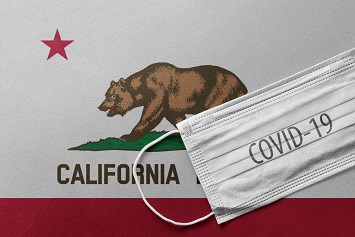The California Division of Occupational Safety and Health (Cal/OSHA) issued interim guidance for protecting employees in hospitals from exposure to SARS-CoV-2 and a guide to the state’s Aerosol Transmissible Disease (ATD) standard.
Coronavirus disease 2019 (COVID-19) is a respiratory illness caused by the SARS-CoV-2 virus.
California’s ATD standard requires that employers protect workers at healthcare facilities and other services and operations from airborne diseases like COVID-19 and tuberculosis (TB), influenza, and pertussis (whooping cough). There is no corresponding federal standard.
Requirements under the standard include written programs and procedures; engineering and work practice controls; biosafety plans for laboratories; respiratory protection; medical services such as vaccinations and postexposure evaluations; and follow-up, training, and recordkeeping.
Written ATD plans for hospitals must, at a minimum, include:
- Name or title of the person, knowledgeable in infection control measures, who is responsible for administering the hospital’s plan;
- List of job classifications that have occupational exposure to aerosol transmitted diseases and that perform high-hazard procedures;
- List of all high-hazard procedures and operations performed in the hospital and by hospital employees, as well as all assignments or tasks requiring personal protective equipment (PPE) and/or respiratory protection;
- Methods of engineering controls, work practices, PPE, and respiratory protection to be used under the plan;
- Source control measures implemented at the hospital, such as ensuring patients with suspected or confirmed COVID-19 are masked when possible;
- Procedures to identify, temporarily isolate, and move suspected and confirmed COVID-19 patients to isolation rooms or areas—procedures must include methods to limit employee exposure to patients when they are not in an airborne infection isolation room or area;
- Procedures to communicate with employees and other employers regarding the suspected or confirmed infectious disease status of persons to whom employees are exposed and procedures to investigate and evaluate each exposure incident;
- Descriptions of medical services and training under the plan;
- Procedures to ensure the hospital has an adequate supply of PPE and other equipment used to minimize employee exposure to aerosol transmitted diseases in normal operations and foreseeable emergencies, such as surge events; and
- Procedures for handling surge events that include appropriate work practices, decontamination facilities, and PPE.
Training must cover descriptions of SARS-CoV-2 and COVID-19; signs, symptoms, and modes of transmission of COVID-19; tasks and activities that may expose employees to COVID-19 and source controls to be used with suspected and confirmed COVID-19 patients; use and limitations of methods to prevent or reduce exposure to COVID-19, including engineering and work practice controls, PPE, and respiratory protection; the employer’s surge plan; and what to do if an exposure incident occurs.
Engineering controls include isolation rooms and airtight barriers to eliminate employee exposures, as well as air disinfection, high efficiency particulate air (HEPA) filtration, and local exhaust ventilation in patient rooms.
Work practice controls include:
- Limiting the movement of suspected and confirmed COVID-19 cases within a facility;
- Bundling or combining care activities to minimize room entries;
- Screening, delaying, or redirecting elective and nonserious visits when possible;
- Using alternative means of communication, such as telephone and video calls, when possible and medically appropriate;
- Placing multiple patients infected with the same respiratory pathogen together in dedicated areas—a practice known as “cohorting”;
- Cleaning and disinfecting work surfaces, tables, tools, instruments, and equipment frequently using EPA-approved products (List N) for use against COVID-19;
- Washing articles and linens after each use; and
- Implementing frequent hand-washing procedures and procedures for safe donning and doffing of PPE and respiratory protection equipment.
Appropriate PPE includes coveralls or gowns, eye and face protection, gloves, and respirators. Healthcare facilities have experienced shortages of filtering facepiece respirators such as N95 respirators during the pandemic. Due to shortages, employees otherwise required to wear an N95 respirator should be provided with surgical masks. Employers must manage respirator supplies to prioritize the protection of employees engaged in high-hazard or aerosol-generating procedures.

